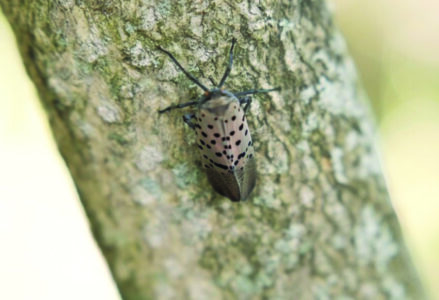Changing times
Learning to share space with urban wildlife

Sharing living space with animals, such as this coyote, that once roamed wooded areas is becoming an increasingly common activity for humans. This development, which has taken place over many years, has meant changes in how people deal with these animals, experts say. (Photos courtesy of the Michigan Department of Natural Resources)
- Sharing living space with animals, such as this coyote, that once roamed wooded areas is becoming an increasingly common activity for humans. This development, which has taken place over many years, has meant changes in how people deal with these animals, experts say. (Photos courtesy of the Michigan Department of Natural Resources)
- Canada geese are often seen in urban areas. (Photo courtesy of the Michigan Department of Natural Resources)
But wildlife isn’t just the big, iconic animals we tend to think of, it includes smaller species like bumblebees and butterflies. Chances are, many have had first-hand experience with a wild animal no matter where you live.
Wildlife is all around us. People all share the same habitat and are connected as different parts of the same ecosystem.
Snakes, coyotes, hawks and owls all prey on smaller mammals, some of which people frequently view as pests, like mice and rats. Wildlife like turkey vultures could be considered a sort of clean-up crew as they scavenge and consume unsightly roadkill.
Because wild animals of all sizes can be found throughout Michigan, they provide benefit to whatever habitat they live in, from forests and wetlands to farmlands and cities.

Canada geese are often seen in urban areas. (Photo courtesy of the Michigan Department of Natural Resources)
Living with our wild neighbors
Amazingly, many species have adapted and figured out how to survive in human-altered landscapes.
Wild animals have been able to find a way to meet their needs even within our inner cities. Whether we intend to or not, people have changed the available habitat. We have created new habitat for ourselves and in the process created new habitat for wildlife.
Not all species have been able to adapt to these dramatic changes to their landscapes, but many have.
People cannot exist apart from wildlife, so we should put in a little effort to coexist with our wild neighbors.
If you enjoy watching wildlife, there are a variety of steps you can take to improve your property for wild animals, even in urban areas. Pollinators such as bees and monarch butterflies — whose populations have declined dramatically in recent decades, threatening the food sources they pollinate — need places to stop to get food. You can plant a variety of plants in pots that can be attractive to these species, making even a small balcony a wildlife refuge.
Get started with tips and information for creating and maintaining wildlife habitat at Michigan.gov/Wildlife and in the Landowner’s Guide.
Conflicts with wildlife
As with any neighbor, you might not always get along with wildlife or approve of their behavior. Fortunately, there are some options to deal with an unwanted visitor to your area.
“If you wanted to attract wildlife to your property, you would consider what food or shelter you might be able to provide to them,” said Brian Roell, a DNR wildlife biologist from Marquette. “Discouraging wildlife follows a similar thought process, but instead of adding things like food or shelter for the wildlife, you would want to remove it.”
Making your area an unappealing habitat is a good first step to take to reduce the potential for conflicts.
Roell suggests removing potential food sources, especially bird feeders, and not leaving pet foods outside – you never know who might come around looking for a free meal.
You can also try some “hazing” methods, which include tactics like making loud noises, to make the wildlife view you as the unfriendly neighbor and seek a quieter neighborhood.
Check out our How to Haze a Nuisance Coyote video for hazing techniques and tips that can work on more than just coyotes.
Being a good neighbor to wildlife is as simple as being mindful about how your actions or property could be an attractive habitat. From there, you can make changes to either make your property more appealing to certain species or less so.
Tips and information on how to handle conflicts with wildlife are available at Michigan.gov/Wildlife.
When habitat changes are not enough
There are always those situations where, no matter what you do, you cannot seem to discourage an animal from your area. Especially when it is one of Michigan’s well-adapted species like coyotes, deer, turkeys and geese, which seem to thrive in urban areas.
These animals may be well-suited for living in manmade habitats and hard to deter.
This is especially true of a species like coyotes, which are territorial and may be less keen on leaving “their” space to go elsewhere. Not only are coyotes found everywhere in Michigan, but they have healthy populations, so there probably are not many unoccupied territories left to choose from.
If you live in a more rural area where outdoor recreation activities like hunting and trapping are allowed, you can remedy some of these issues during the open season for the species causing the headache.
“Hunting and trapping seasons give landowners options for mitigating issues with wildlife, while still preserving them on the landscape,” said Adam Bump, the DNR’s furbearer specialist. “There are also some species that can be taken year-round.”
Bump says that coyotes, raccoons, woodchucks (groundhogs) and skunks can be killed at any time by landowners or their designees employing otherwise lawful methods if these animals are doing, or about to do, damage to private property.
Information on hunting in Michigan can be found at Michigan.gov/Hunting. Species that have open trapping seasons and associated regulations can be found at Michigan.gov/Trapping.
What about urban areas where hunting is not an option?
“The DNR issues permits to businesses that can provide wildlife removal services for certain species,” said Casey Reitz, wildlife permit specialist with the DNR. “This helps give landowners an option for dealing with unwanted wildlife on their property, particularly in those areas where hunting is not allowed.
“Permittees use a variety of methods for removal that are safe in an urban or residential setting. They can help landowners with removal of species like coyote, fox, muskrats, opossums, squirrels, woodchucks and skunks, to name a few.”
Find the Nuisance Wildlife Control Directory at Michigan.gov/Wildlife.
The DNR also works closely with federal agencies to offer options for handling issues with Canada geese, a species protected by both federal and state laws, in urban areas. Specially permitted nuisance control companies can be hired to assist landowners with goose control programs. The U.S. Department of Agriculture’s Wildlife Services also offers removal assistance, such as nest destruction and relocation permits.
Aggressive animals
In those instances where there is an aggressive wild animal, particularly animals such as geese, swans, turkeys, deer and bears, landowners should get in touch with the nearest DNR Customer Service Center to let the local DNR staff know about the issue. As each situation is unique, staff will first assess the problem and then determine the appropriate action based on the species and location.
Landowners can contact one of the nuisance wildlife control permittees for assistance with removal of species such as coyotes, fox, raccoons, opossums and skunks.
Additional tips
Additional tips and information on how to handle conflicts with a variety of wildlife species are available at Michigan.gov/Wildlife, under “Living with Wildlife.”
If you have found a baby animal in your yard, which is a common occurrence in the spring, it is best to leave it be. You can also get in touch with a licensed wildlife rehabilitator for assistance. Learn more about what to do if you find a baby animal at Michigan.gov/Wildlife, under Keep Wildlife in the Wild.






